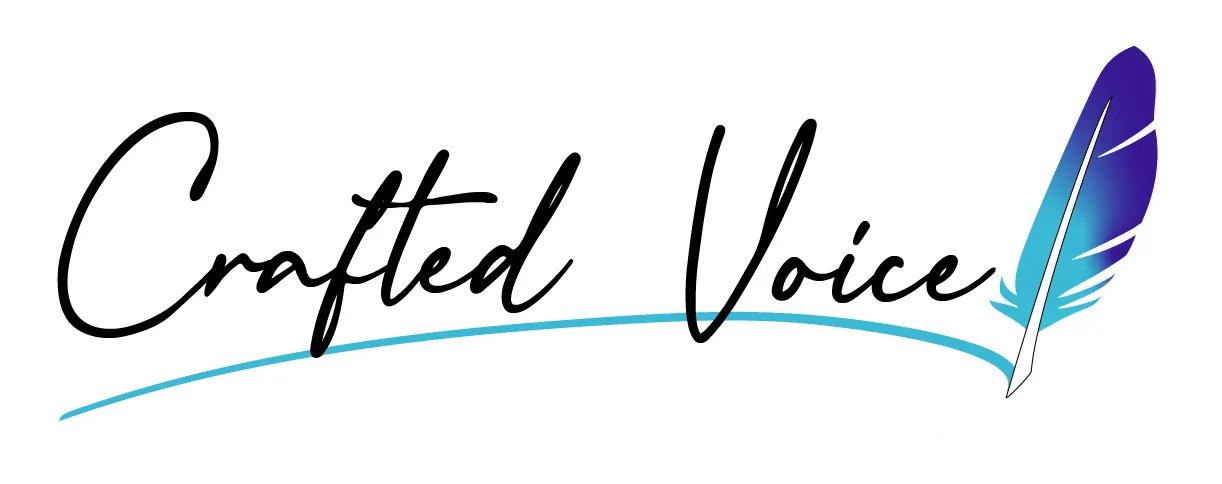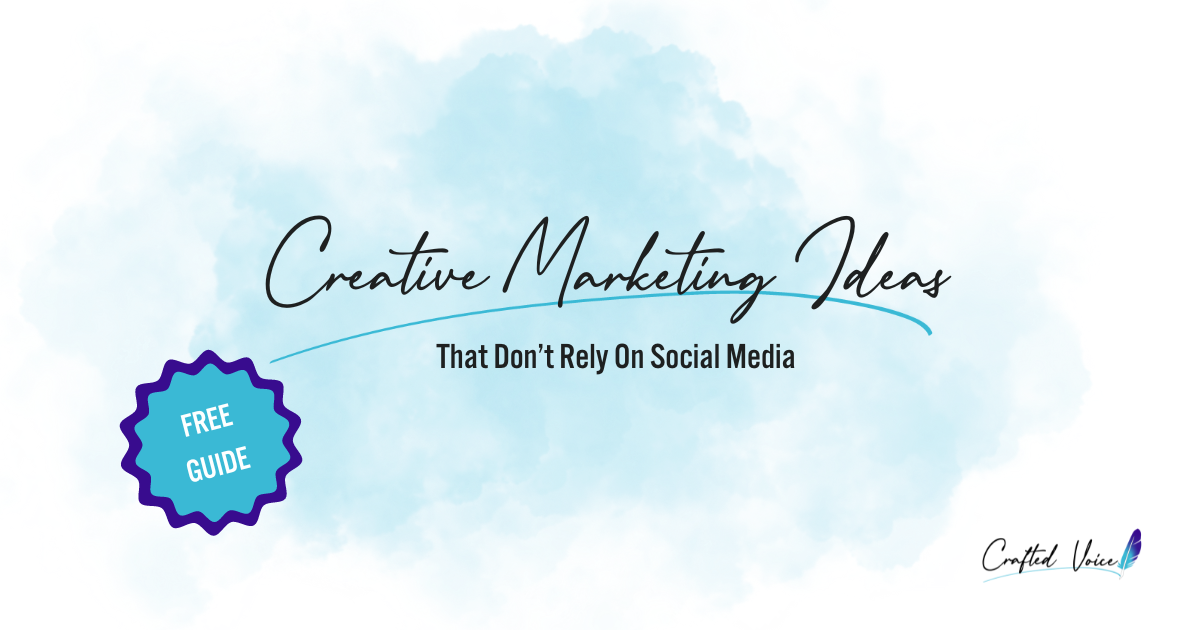Marketing Resources For Small Business
Tips for elevating your business from beginner to high-caliber pro by strategically investing in high quality marketing resources.
Elevate your business from beginner to high-caliber pro by strategically investing in high quality marketing resources.
A few years ago, I took a just-for-fun online art class with a few colleagues to learn how to paint with pastels. I enjoyed it enough to purchase a cheap pastel set from my local craft store. They didn’t have pastel paper, so I grabbed some watercolor paper instead. When I got home, I looked up easy pastel tutorials online and quickly discovered that my starter box of 15 pastels and paper meant for watercolor paint was incredibly limiting. Instead of 7 hues of green to choose from, I had 3, which meant I could not create the same magnificent color and blending effect that my digital teacher was prompting me to blend into creation. And the bumps in the paper kept messing with the process.
I improvised, but ended up with something that was just OK. If I had invested in the right pastels and paper, instead of just the cheapest and most convenient options I could find, my creative product would have been much better.
It’s similarly easy to invest in business in the same way. We choose what is cheapest because it’s kind to our budget and choose the most convenient because we are strapped for time. There is tremendous value in finding “perfect fit” marketing resources for small business.
If you want to elevate your business’ strategic communications and marketing from the equivalent of drawing stick figures to painting Claude Monet masterpieces, Crafted Voice provides expert guidance and data-driven insights for a strong brand presence.
This article is filled with tips to equip yourself and your business with the tools you need to move beyond the frugal beginner and level up to an invested expert in your industry. We also offer strategic communications and marketing business coaching to serve as a partner where you need the support the most. Schedule a free consultation with our team today to learn more about how a partnership with Crafted Voice could elevate your business.
How to market small businesses online
When you first learn a new skill like painting, it’s daunting to watch a professional like Bob Ross paint little, happy trees. He makes it look so easy! What isn’t obvious from a casual observer is that he has carefully chosen high quality tools and has them nearby and ready when he needs them. Pair his expert choice of tools with his years of experience and training under qualified mentors… of course he makes it look easy! He’s both prepared and skilled.
In the same way, there are so many ways to market your business online, it can be overwhelming to get started when you observe already successful companies. You might be sweating a bit as you ask yourself, “which tools do I need, what expert advice can I trust, and where do I start?”
Many startup businesses think they have to show up in all the places, which means having a handful of social media pages to manage, a presence on all of the online directories and review sites, on top of doing SEO and email marketing. Marketing is easily a full-time job, which can be a challenge for solo entrepreneurs and small businesses that can’t yet hire a marketing employee or expensive agency.
The best solution to this marketing overload problem is first to build a solid foundation for your workflow and brand:
Step 1: What's Your Plan?
Start by deciding how you’ll handle your marketing efforts. Will you take the DIY route, or bring someone onto your team to manage it? If you will be doing the work, consider investing in high-quality, on-demand e-courses to sharpen your skills. If you have the budget to hire a consultant or agency, you can access expert advice on an as-needed basis. Choose the approach that aligns best with your business model and goals, then move forward with confidence in your decision. Remember, you know your business best!
Step 2: Who's Your Audience?
Dive deep into understanding your target audience. Where do they spend their time? What challenges, motivations, and frustrations do they face? How do they prefer to receive information? What are their shopping habits? Answering these questions will help you tailor your marketing messages to meet their specific needs and position your business as the ideal solution. If you are taking a DIY route, we offer an on-demand e-course for creating data-driven customer personas. We also offer do-it-for-you customer persona services.
Step 3: Who's Your Competition?
Hone your detective skills by closely studying your competition. Your competitors can offer valuable insights into what works and what doesn’t when it comes to reaching your target audience. Consider doing some mystery shopping, signing up for their emails, reading customer reviews, and exploring their websites. Sometimes exploring the best marketing strategies used by companies is the best place to begin your research. Understanding how they communicate with their customers and what marketing strategies they use can guide your own efforts and highlight any gaps you can fill to stand out in the market.
Step 4: What's Your Message?
Develop your core brand messaging. With a clear understanding of your target audience and the market landscape, you can craft key messages that will resonate with your audience. Carefully craft an elevator pitch, a catchy one-liner, a compelling story, and brand voice guidelines as essential components of your anchor messaging. These guidelines will direct all of your marketing campaigns moving forward.
Step 5: What's The Journey?
Chart a customer journey map for your customers to follow. This isn’t a literal map that you will hand to your customers. Rather, it’s an internal marketing resource that you will use to be strategic about the touchpoints your customers have with your business and will help you track conversions.
Step 6: What's The Plan?
Create a plan of action in the form of a marketing editorial calendar. Will you send out a newsletter? Engage on social media? Does blogging on your website make sense, and if so, how often? An editorial calendar will help you organize your marketing strategy and keep you on track. Just remember, you don’t have to do all the things. Look back at your customer personas and your competitive analysis to determine which platforms make sense. If it’s just one or two – great! That allows you to really focus on executing great campaigns instead of spreading out your focus across multiple areas.
Step 7: What's The Cadence?
Stay consistent and stick to your plan. Consistency is key to staying top of mind with your customers and building a strong brand presence. Of course, be flexible when you need to be and experiment with things that don’t look like they are converting the way you want them to. The key is to balance consistency with flexibility to maximize success.
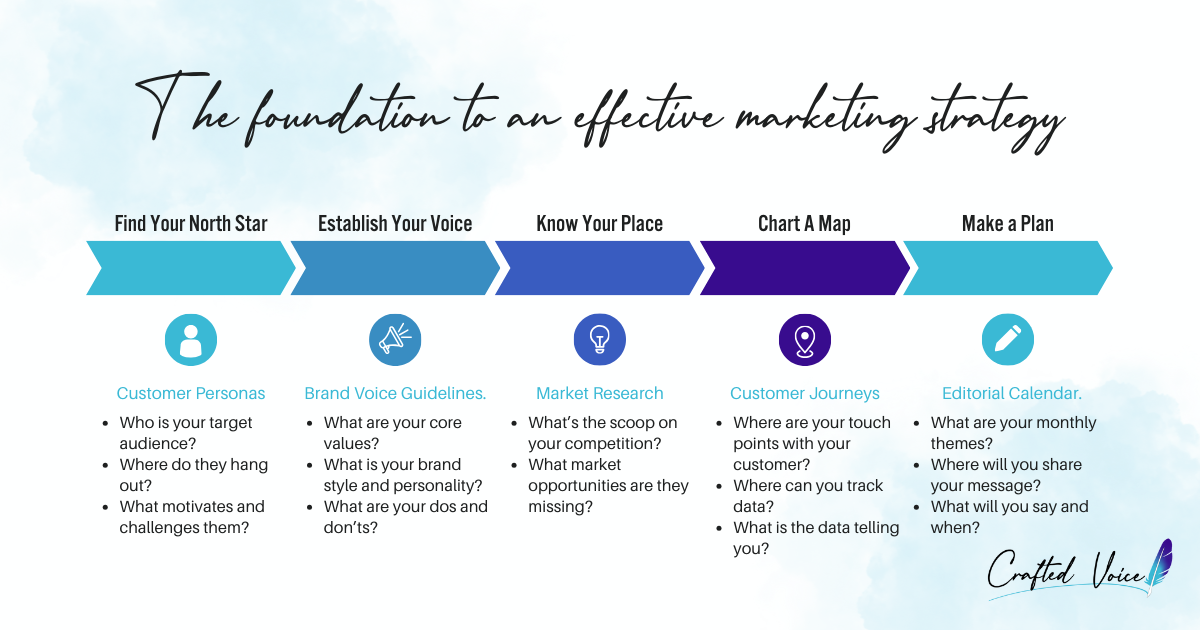
What are marketing resources?
Marketing resources are tools that help you get the word out about your business.
- Internally, these resources may include a customer relationship management (CRM) tool, a marketing resource management tool, graphic design software, and a data analytics tool. These are just a few examples.
- Externally, marketing resources may include social media platforms, an email marketing platform, or a public, community forum.
The best marketing resources for small business are those that allow you to target your workflow, messages, and marketing activity execution towards your customer personas. Without customization, you are just more noise in a crowded marketplace.
How much does digital marketing cost for a small business?
Setting a marketing budget can be a tough task for startups, small business owners and solopreneurs. There are many free marketing tools for startups, but free can only take you so far with your professional marketing. Not to mention the fact that “free” often means you are putting in your own time, which isn’t free. Time is money, after all, and should be considered in your cost of doing business when it comes to your marketing budget.
Fractional CFO and Crafted Voice client Geneve Huxley, shares her financial wisdom when it comes to setting a budget:
“The first thing to remember about setting a marketing budget, is that you are playing the long game. You need to get your name/product in front of people many times before they make a decision to reach out to you. So whatever amount you decide on means that when you set your budget, you need to be able to stick with it for at least a year, and preferably several years. It’s much better to spend a steady amount month over month (like dripping water) than spend a ton of money on one blitz for 30 days. So pick a budget number you have a high likelihood of sticking with for several years.”
Gain more insight and tips on marketing costs in our blog, How do I market my business on a tight budget?
What type of marketing is best for small businesses?
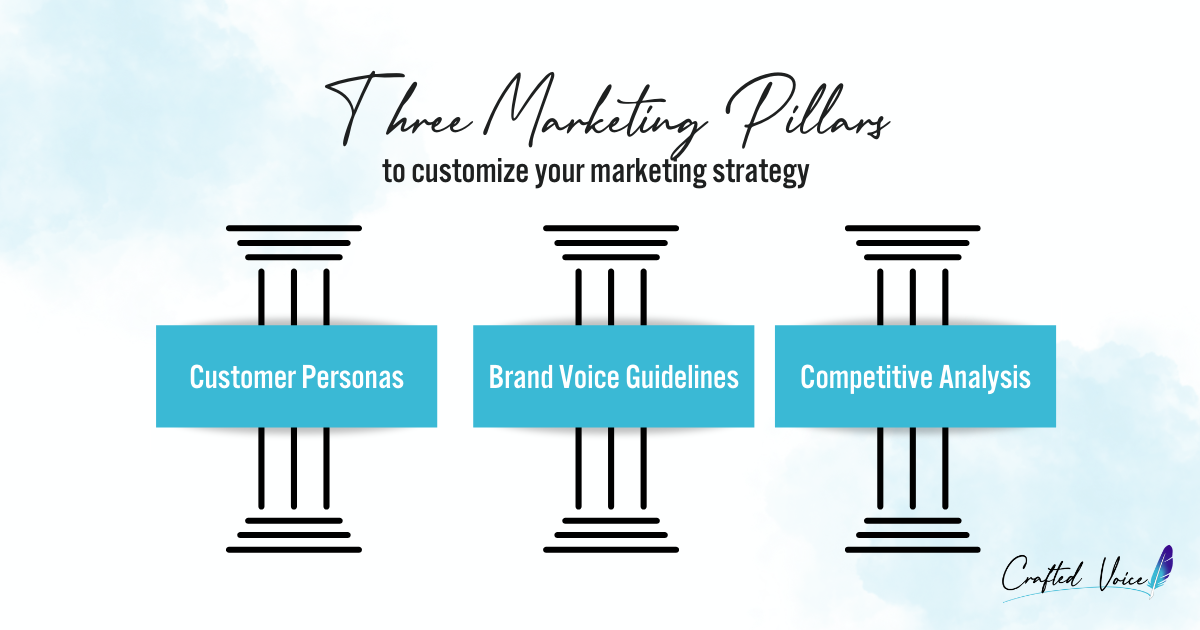
These three foundational marketing pillars should inform the type of marketing that is best for your business.
- Your North Star: A Customer Persona is a tool used to target the most relevant audience for your business.
- Your Anchor Messaging: Brand Voice Guidelines clearly defines your brand voice and how to communicate it across teams and platforms.
- Your Market Location: A detailed competitive analysis inspects your competitors and their marketing strategies.
There is not a “one-size-fits-all” solution when it comes to marketing. For more insight, read our blog, What Type Of Marketing Is Best For Small Business.
What is the most successful marketing tool for small business?
Your strategic communications and marketing plan should be the #1 fan of data-driven decision making. A thorough and well-thought out data analytics tool is truly the most successful tool you can have in your toolbox. Regularly analyzing marketing metrics and adjusting strategies based on performance can help optimize marketing efforts and maximize ROI.
While the data may seem daunting, I can tell you as a former hater of data…I’ve grown to love data analytics because of the story those numbers tell.
For example: are my customers suddenly falling off the face of the planet after email campaign send #3? The data tells me where, why, and provides an opportunity to experiment. If I change the email content and my numbers improve, I know I’m more effective in my marketing efforts than before.
Don’t let data scare you away from the exciting opportunity to experiment and improve results. Most marketing platforms offer their own data insight tools, which you can review separately, or you can use a tool like Google Studio to pull various data sources together into one dashboard. Whatever method you choose, keep an eye on the data – monthly at a minimum. Weekly insights can help with the more day-to-day activities while monthly and quarterly reports can provide insights into campaign performance. Hiring a data specialist who is an expert in marketing insights is a great investment for businesses looking to uplevel their marketing game.
How do I share marketing data effectively?
Don’t just share data for the sake of sharing data – you’ll put your audience to sleep. Instead, take advantage of Donald Miller’s Storybrand Framework to frame the data in a way that resonates and spurs your audience to action.
Here’s a snapshot of the framework:
-
- Set your audience as the hero of the story.
- State the problem they are experiencing.
- Establish the data as the guide who understands their fear in relation to their problem.
- Give them a data-driven plan to overcome their problem.
- Give them a call to action.
- Make it clear what’s at stake if they don’t “follow” the data, but also what they could achieve.
- Acknowledge the transformation that can occur if they take action.
Share the data with a story!
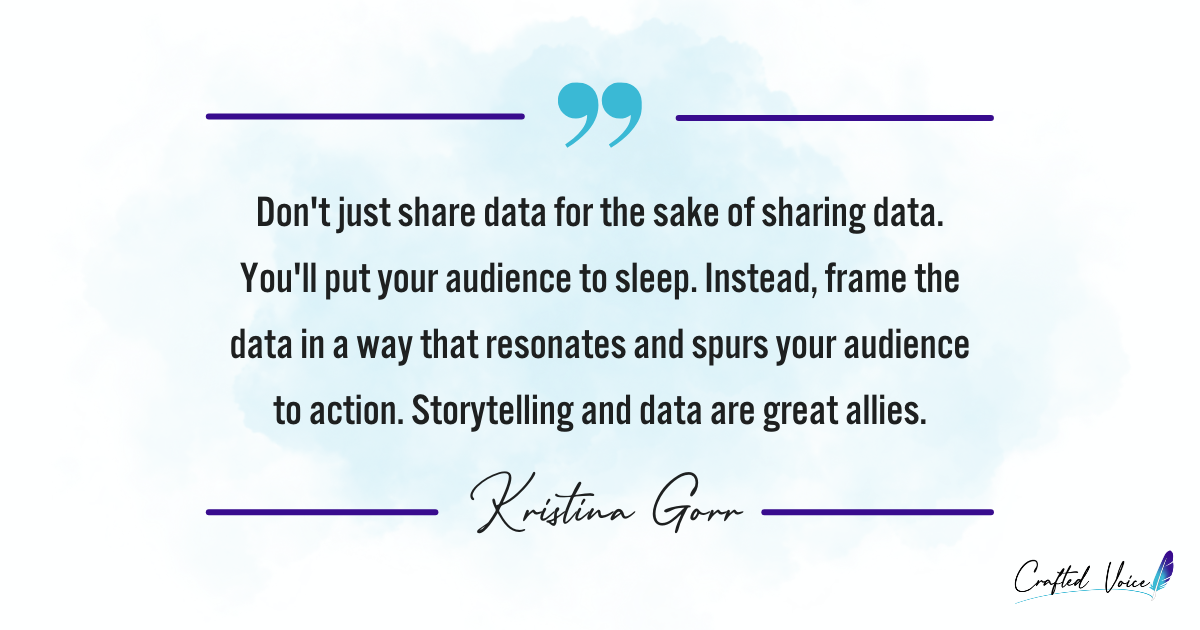
What is the best marketing platform for small business?
I have a client who is a huge fan of HubSpot, and uses it for everything from scheduling social media posts to SEO to tracking sales. If you have the budget (at the time of this writing, its cheapest option outside of the limited free version is $800/month), it’s a great tool.
If you don’t have that kind of budget for an online marketing platform for small businesses, keep your marketing simple. If your customer personas provide insight that they are only on one social media platform and also check their email, then conduct your marketing activities on that social media platform and send emails through a simple, free email platform. The free versions of Mailchimp and Constant Contact are quite good, and their first tier is only a few dozen dollars a month, not hundreds. You may not need all of the fancy bells and whistles of a full blown marketing strategy platform. If that’s the case for your business, keep it simple for an effective workflow.
How can small businesses use digital marketing?
It’s easy to find 101 marketing ideas for small businesses by doing a quick google search. Especially when it comes to using social media marketing tools for small business. But how do you market creatively when you don’t want to get stuck in the daily rut of just posting to social media?
Sign up for a free download of 45 ideas that you can leverage to reach your target audience without the boring go-to marketing activity: “post it on social media.”
How can small businesses use digital marketing?
It’s easy to find 101 marketing ideas for small businesses by doing a quick google search. Especially when it comes to using social media marketing tools for small business. But how do you market creatively when you don’t want to get stuck in the daily rut of just posting to social media?
Sign up for a free download of 45 ideas that you can leverage to reach your target audience without the boring go-to marketing activity: “post it on social media.”
What are marketing resources in business?
The best marketing tools for business are those that work for you, allowing you to flex and adjust your strategic communications and marketing strategy to fit your unique business model, your industry, and your target audience. The resources available in today’s economy of digital platforms provides ample opportunity to explore and experiment, discovering what works best for you and your business before making a commitment to any one platform. Embrace the space to explore and take your time carefully deciding what option will set your business up for success.
Looking for Vetted Marketing Resources To Save You Time?
Crafted Voice has spent years sleuthing through all of the free resources out there, exploring their options and features. If you are looking for a trusted marketing partner who can provide a shortcut through the seas of available options, schedule a free consultation with our team to guide you in the right direction. From high-quality on-demand resources, to concierge services, we can support you where you need it most, saving you time and money as you get closer to reaching your business goals.
Reach Us
We’re proud to serve business owners where we call home in the greater Columbus, Ohio metropolitan area. We also serve clients from coast-to-coast.
Together, let’s craft your story and captivate your audience!
Hilliard, Ohio
